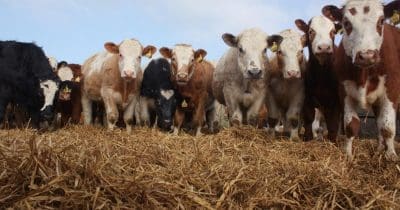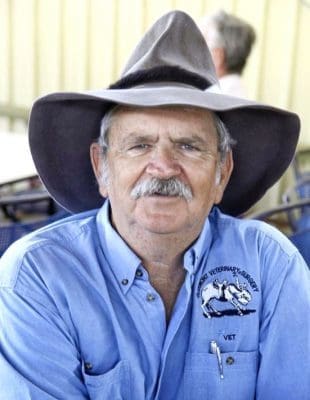
Bodies of small animals such as lizards, snakes, turtles, rates or mice are common types of rotting organic matter that can contaminate feed. Image: Oli/Flickr
With the deteriorating season in northern Australia has come new anecdotal reports of cattle succumbing to botulism.
While not believed to be widespread at this point, the risk posed by drying seasonal conditions has triggered timely warnings from veterinarians and cattle nutrition experts about the importance of preventative vaccinations and nutritional supplementation to offset protein and phosphorus deficiencies.
Désirée Jackson from Désirée Jackson Livestock Management in Longreach said a common problem is that many producers mistakenly only associate botulism risk with Phosphorous-deficient country.
“When cattle are protein-deficient, they will also chew carcases,” she explained.
“Also, once cattle develop the habit of chewing bones, they tend to continue to do this.
“Ensuring phosphorus and protein are adequate in the diet in addition to botulism vaccination, is critical.”
Not planning ‘like playing Russian Roulette’
Taking preventative action is like insurance, she said.
“Most of the time it isn’t a problem and some properties may get away with it, but it’s like playing Russian roulette.
“When properties do get affected by it, they don’t normally lose one or two animals – they lose significant numbers.
“At the current market prices, this amounts to huge dollars in mortality rates if a property is affected.
“I strongly recommend that even on properties in northern Australia where there is no history of botulism, that properties vaccinate, using correct protocols such as ensuring animals receive boosters at the correct time and good vaccination protocols (i.e., not exposing the vaccine to sunlight in the yards and keeping it cool)”.
‘Some areas think they haven’t got it, but they have all got it’

Dr Alan Guilfoyle
President of the Australian Cattle Veterinarians Association, Dr Alan Guilfoyle, who owns and operates the Clermont Veterinary surgery in Central Queensland, agreed there was a common misconception that risk was confined only to phosphorous-deficient country.
“It sticks its head up every time it is dry, some areas think they haven’t got it but they have all got it,” Dr Guilfoyle said.
“It is not only chasing phosphorous, your phosphorous deficient country is protein deficient.
‘it is a protein deficiency that sets it off’
“I have had cases up on the black soil plains, as soon as you get frosts the country gets pounded and they start chasing protein.
“On phosphorous-deficient country they chase bones, but a lot of the time they will just chase meat – decaying carcases, anything – it is a protein deficiency that sets it off.”
1080 baits can also pose a risk to cattle
Producers may not be aware that cattle chasing protein can also be drawn to picking up baits treated with 1080 poison to control wild dogs.
“I have seen this time and time again,” Dr Guilfoyle said.
“Don’t just drop them willy nilly around the place, because cattle will chew on that old meat.
“I have seen cattle demolish an old carcase, particularly weaner mothers trying to pick up after having a calf. Weaners will chase it too. If they have a high protein, high energy demand, they will eat anything.”
Decaying organic matter can introduce botulism
Another risk factor is when stock have access to old decaying organic matter.
Many previous cases of been caused by contamination of feed or water by rotting organic matter containing the botulism toxin or bacteria. Bodies of small animals such as lizards, snakes, turtles, rates or mice that are inadvertently trapped in grain, hay or silage during the harvesting or storage stage, or die in stored feed, are common types of rotting organic matter that can contaminate feed. High moisture feeds such as silage or brewer’s grains when allowed to rot rather than ferment can also provide an ideal anaerobic environment for botulism growth.
Dr Guilfoyle said he recently had a case of a horse crashing with botulism after it had been kept in a yard and fed hay.
“Old decaying hay on the ground is a pretty good source of botulism,” he said.
‘With any fodder conservation there is always a danger of a rat or a snake dying in there’
“Botulism is everywhere, it can come out anywhere, and particularly in the more intensive areas once they start to feed. With any fodder conservation there is always a danger of a rat or a carpet snake dying in there.”
Dr Guilfoyle said the best reminder producers needed to conduct preventative vaccinations was “the bloody big hole in their pocket” they would see when they started to lose cattle to the toxin.
“Botulism in all areas should really be a number one vaccine,” he said.
“It is one of the things that should be on the to-do-list every time you have got weaners, on any type of country.
“There is an adage that says if you vaccinate for botulism you cure 25 diseases. In other words botulism is the causative agent in a lot of serious deaths.”
If producers suspect their cattle may be succumbing to botulism poisoning, Dr Guilfoyle said the first thing they should do is contact their local cattle veterinarian.
‘Half a job won’t work’
The most important message was to spend the money “to do it properly”.
”If you are going to do the job, you have got to do it right.
“Some people will say, we don’t need to vaccinate, we will just put some lick out. It is not enough.
“You can spend $5 and lose. You can spend $15 and gain $30.
“Do the proper job and you will get rewards. Do half a job and you will be frustrated and disillusioned and disappointed. You are in the game where you have got to spend money, look after your cattle and they will look after you.”
More information on Botulism in cattle:
- Causes: Botulism is caused by the ingestion of the toxin produced by the bacterium Clostridium botulinum.
- As it caused by ingestion of a toxin, it is not an infectious disease, a sick animal cannot infect a healthy animal.
- Botulism has been commonly seen in phosphorus deficient areas of northern Australia, where it is often associated with cattle eating bones and carrion to satisfy a craving for phosphorus and/or protein.
- However reports of botulism have become more frequent in areas that are not phosphorus deficient. Many of these outbreaks have been in intensively fed beef and dairy cattle operations, and where stored feed has been introduced to cattle, such as for supplementation during drought.
- Many cases of botulism have been due to contamination of the feed or water by rotting organic matter containing the botulism toxin or bacteria. Bodies of small animals such as lizards, snakes, turtles or mice that are inadvertently trapped in grain, hay or silage during the harvesting or storage stage are some of the common types of rotting organic matter that contaminate feed.
- High moisture feeds such as silage or brewer’s grains when allowed to rot rather than ferment can provide an ideal anaerobic environment for botulism growth.
- The carcases of botulism-affected animals can also provide an ongoing risk for further cases of botulism.
- Symptoms: Botulism causes a progressive paralysis and animals die of respiratory failure from paralysis of the breathing muscles.
- Affected cattle tend to have a stiff gait and saliva drools from their mouth. They are usually found sitting down, unable to rise and their breathing becomes progressively more laboured. Frequently they extend their hind legs behind them in a frog legged position to make breathing easier. Some animals have tongues that hang out and do not retract when pulled.
- Animals affected early in the outbreak tend to have a short clinical course (12-24 hours) and die quickly but later in the outbreak they can have a longer clinical course and some may even survive. Losses can be seen for up to 17 days after ingestion of a contaminated feed.
- Prevention/Treatment: Botulism usually involves multiple cases, has no association with calving and does not respond to calcium injections. Ephemeral fever (3 day sickness) can also resemble botulism but affected animals usually have a fever and are usually down for only a few days. They often improve with calcium injections and cases tend to be seasonal affecting many herds within a region.
- The main preventative strategy is to vaccinate the herd.
- In the pastoral areas where botulism is endemic vaccination is widely adopted and it provides good protection. In the intensive industries botulism is still uncommon but for individual producers the financial consequences can be dire and vaccination is recommended for all producers who are feeding cattle silage, grain, by-products or mixed rations.
- Once an outbreak has started, vaccination is unlikely to make much of an impact, so it is important to vaccinate on a regular basis before you get a problem.
- Apart from vaccination, other management practices can reduce risk factors for botulism, they are:
- Preventing stock access to animal carcases.
- Controlling vermin and pest animals to reduce the risk of spread of putrid material.
- Providing nutritional supplements of protein and phosphorus to reduce bone chewing among pastoral-zone cattle
- Taking care with the harvesting and storage of feeds to reduce the possibility of small animals contaminating feeds
- Checking water sources for organic matter contamination.
- Human health risk ‘insignificant’: In the case of dairy cows affected by botulism, the risk of botulinum toxin entering milk supplies from cattle suffering from botulism is considered insignificant by experts. Cattle affected by botulism generally cannot be milked. In addition, the toxin is extremely unlikely to pass from blood into the cow’s milk.
- However, immediately notify milk factories if you suspect that your cattle have botulism and potentially affected cattle have contributed to your bulk milk supply.
- For beef or dairy cattle that survive outbreaks of botulism and are fit, healthy and normal, there is no known risk of botulinum toxin remaining in the carcase and subsequently poisoning people.
Sources: NSW Dept of Primary Industries, Queensland Department of Agriculture and Fisheries. Further information at this link: https://www.daf.qld.gov.au/animal-industries/welfare-and-ethics/animal-welfare/natural-disasters/animal-disease-issues-after-flooding/infectious-diseases/botulism
